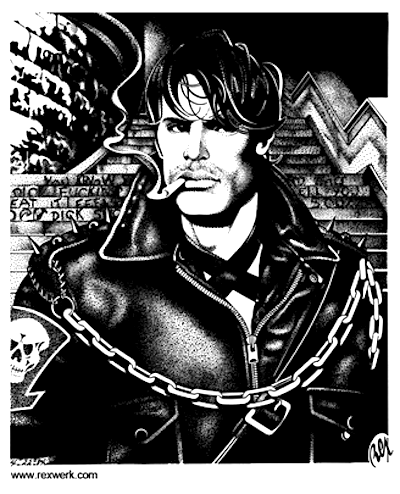
REX
REX is without question one of the most influential artists on the visual representations of gay male kink and leather in the post-Stonewall era —the period of dramatic institutional expansion, unapologetic self-affirmation, and exhilarating exploration that the AIDS epidemic will bring to an abrupt halt.
Put differently: after the generation of artists of the era of “classic leather” — Tom of Finland, of course, and Dom Orejudos aka Étienne, but also, often forgotten now though no less influential then: Steve Masters aka Mike Miksche, George Quaintance, or Chuck Arnett — he is part of the group of artists who will define he iconography of what might be termed “the golden age of leather” — with people like Bill Ward or Martin of Holland as well as The Hun or Al Shapiro.
He may well, in fact, be the most prominent of all.
In unison with his generation, in his drawings, REX celebrates not just masculinity, leather, uniforms, rough sex and big dicks, but also — overtly, unapologetically — the joys of orgies and bathhouses, sexual exploration, and extreme, wild and kinky sex. Unwilling to sanitize kink to make it look harmless and acceptable, he often throws into sharp relief the fantasies and fetishes most would rather keep untold — perhaps because he remembers the great lesson of the Stonewall generation: that the path toward de-stigmatization starts with naming.
Present everywhere
For REX’s work is one with the movement for kink affirmation. Most directly, his drawings are inseparable from the burgeoning of leather institutions in the late 1970s and early 1980s. His name may not have been known by the public at large at the time, but his drawings were.
Starting in 1977, REX contributed very regularly to Drummer and, through the magazine, his work was noticed and admired by kinky men on both sides of the Atlantic (see the contribution by Ad Shuring below). In San Francisco, as Gayle Rubin recalls below, his art was used in the advertising of many key leather institutions, and they immediately gained an iconic status as symbols of the kinky visibility of the Folsom neighborhood. Case in point: in 1980, a bakery in South of Market was advertising in their window a cake with the “Taste of Leather” design in icing. To which REX reacted jokingly: “You really know you’ve arrived when you see your art work copied on a cake!”(Drummer, 37, p. 64).
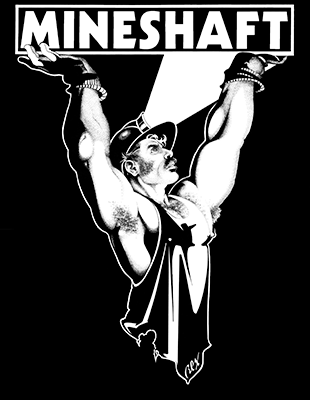
But it is through his association with the Mineshaft in New York City — without question the most notorious and legendary SM sex club in the world at the time and perhaps even since — that REX’s work gained the most visibility. In 1976, manager Wally Wallace commissioned him to design a poster for the club. A hot, muscular, hairy man wearing a miner’s cap and holding the club’s logo became its symbol. The poster was an instant classic. It immediately became a collector that patrons wanted to own. REX was now the House artist for the Mineshaft and thousands of copies were printed. A T-shirt followed. Over the years, three posters and T-shirts were designed by REX for the Mineshaft. They were sold exclusively at the club. And they sold in the tens of thousands, bought by people from all over the world.
The legend of the Mineshaft is inseparable from these three drawings. In 1978, throughout the video-clip of Queen’s “Don’t Stop Me Now,” a song that combines images of ecstatic fun, speed and limitless power, Freddie Mercury is wearing one of those Mineshaft T-shirts. Throughout the years, the video-clip will be seen by millions, if not billions, over the world. A couple years later, in the infamous Cruising, the posters also appear in the decors built to replicate the atmosphere of the Mineshaft.
Obscure beginnings
The popularity and visibility of REX’s drawings stand in sharp contrast with the humble and obscure beginnings of his career. REX was born in 1942, and was abandoned at birth. He grew up an adopted kid in the rural Northeast. Sometime in his teens, he fled from what seems to have been an extremely oppressive milieu and, in the mid- to late-1950s, the smalltown boy had turned into a runaway kid in the streets of New York City. There, a famous fashion designer noticed him, took him to his Manhattan penthouse, and kept him for 3 years: during that time, he paid for his education at the Cartoonists and Illustrators School which had recently been renamed School of Visual Arts, and sent him to London and Paris to start a career in fashion illustration and commercial art.
In Europe, thanks to the introduction of his benefactor who believed in his talent, REX was introduced in the luxurious world of fashion designers, models, publishers, and fancy cocktail parties. He did not take to it. Instead, he developed an abiding hatred for a world he viewed as artifice, superficiality, and pure appearances. He did, however, enjoy spending long hours walking through European museums. He had a passion for the Italian, 16th century painter, Caravaggio.
While he loathed the glossy world of fashion, REX reveled in the gutter. In Paris, he discovered the pissotières, the public urinals, haunted by anonymous men who, without regard for social status, looks, sexual orientations, or other hierarchies, worshipped the same god. Is that the source of his fetish for uncut dicks? The story does not tell.... In any case, he experienced returning to the streets of New York City as a liberation. He held several jobs for the MAFIA, including boxing club manager.
At some point, in a magazine shop on 8th street, he had the decisive encounter of his life: the drawings of Tom of Finland jumped at him. He never recovered.
Now, REX had found his calling. A few months later, he returned to the same shop to show some art of his own. The owner sent him to a publisher, an Italian man who immediately knew he had the new Tom of Finland in front of him. But first thing first: he needed a name. The young man looked around him. A film was on the desk with a three-letter title. REX was born.
He started doing illustrations for the Rough Trade series. Most importantly, in October 1970, he found The Eagle. The energy was not unlike what he had liked in the t-rooms of Paris and London: men, workers, bikers, sweaty, dirty, masculine, rough, unconcerned with good manners, bonding in an exclusively male space. Outcasts, if not outlaws.
One day that he was working on a sketch there, somebody recognized the illustrator from the Rough Trade Series. He was asked to help with the newsletter of a biker’s club. One thing led to another.
The rest is history.
The house is on fire
July 1, 1981: REX opens his fist gallery, Rexwerk, on Hallam Street, in the Folsom neighborhood of San Francisco. The block where he lives is home to many leathermen, including leather photographer Mark. I. Chester. It once housed the Barracks, a famous bathhouse that closed in 1976 and was then being converted into a hotel.
A month earlier, on June 5, 1981, in its Morbidity and Mortality Weekly Report, the CDC reported the first five cases of what would soon become the HIV/AIDS epidemic.
On July 10, nine days after the gallery’s opening, a construction worker started a fire from the former Barracks. 27 buildings were engulfed. The gallery was in ashes. So were also all of REX’s originals.
The fire was not caused by leather people. Leather people were among its victims. And they were further victimized by the hysteria unleashed by the fire as rescuers, media, and local politicians were going through the rubble, exposing their homes and vilifying their lives, claiming to smell “burning meat,” expecting to find the remains of chained subs and slaves (which, obviously, were never found).
That event, combined with the early signs of the HIV epidemic, marked the beginning of a dark period in REX’s life. His work continued to appear in various outlets for a while; he did several posters for the Saint, in New York City, but he soon stopped publishing for several years.
In the early 1990s, REX returned to New York City and opened The Secret Museum, a “by appointment only” private gallery. Another tragedy would bring this experience to a close: 9/11. By 2002, he had moved back to San Francisco. Eventually, disillusioned about what he perceived as increased political correctness and a suffocating atmosphere of censorship, he moved to Amsterdam in 2010. He still resides there today.
Visible nowhere
Trying to write REX’s life beyond this very broad sketch is an impossible task. There is a lot that is not known. His birth name is not known, nor is his last name. There is no photograph of him we could attach to this tribute: for over 50 years now, REX has consistently refused to have his photograph taken. He himself discourages any attempt to find out more. Some passages allude to a founding moment that started him as an illustrator, but REX won’t say anything about it.
The reasons are unclear. Early on, it may have been a way to avoid legal persecution for his works. It may also be a remnant of the code of silence from the time when he worked for the MAFIA. It may also have worked to add an aura of mystery around his works. Or it may simply a result of an extreme shyness, a feature his friends often mention.
“No other truths out there”
Whatever its reasons, the secrecy is a hallmark of REX’s career. His closest friends point to Wikipedia as the most reliable source. There, he is quoted as saying that his drawings “defined who I became” and that there are “no other ‘truths’ out there.”
For that reason, instead of writing the impossible biography REX never wanted us to read, in order to honor him and his legacy, we take him at his word and let the work speak for itself. Some of the writers below have known REX for many years; others have only ever known his work. All share an abiding admiration and respect for this outstanding artist. We asked them to select a drawing of REX that has a particular meaning for them, and to write a short text about it to mark his induction into the Leather Hall of Fame.
Rostom Mesli
Managing Director & Editor
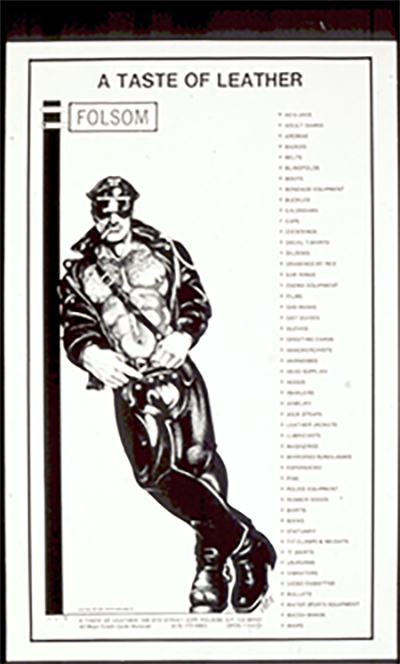
REX and the iconography of San Francisco Leather
REX created much of the look of San Francisco leather, especially during its heyday in the long 1970s. San Francisco leather bars and bike clubs had formed in the early 1960s. But from the late 1960s through the early 1980s, leather institutions proliferated and became a visible presence in the South of Market neighborhood, a formerly industrial and working-class residential district that was being emptied out by deindustrialization, suburbanization, and projects of urban renewal. Leather bars, sex clubs, retail shops, and bathhouses were able to take root in vacated tenements, small scale factories, and neighborhood bars and lunchrooms. Moreover, once Drummer relocated from Los Angeles to San Francisco in 1977, the local leather scene was featured in leather’s major national publication.
REX’s art was a major visual feature of this burgeoning community. He did illustrations for the catalog of the earliest leather shop, A Taste of Leather, and provided the imagery for the posters of several major bars. These included the Black and Blue (memorialized in Frances Fitzgerald’s Cities on a Hill), the Brig (for many years the premiere local S&M bar), and later, the Lone Star Saloon (the first bar to focus on what was then the emerging bear subculture). REX’s work was also often featured in Drummer itself.
But the most iconic image was a poster for A Taste of Leather: it depicted a man in full head-to toe leather regalia, from his biker cap to his heavy engineer boots. His shirtless, muscular, and hirsute torso was framed by the classic motorcycle jacket and transected by a Sam Browne strap, drawing attention to his belt and leather chaps. These framed a bulging basket, to which further notice was emphasized by the placement of his hands, with one finger pointing at his crotch.
But the aspect of this image that makes it so utterly representative of San Francisco leather during this era is that he is leaning, nonchalantly, against a street sign that reads: Folsom. Folsom Street was the main boulevard of this leather occupation, so much that the leather area was often just referred to as “the Folsom.” It had many nicknames, including the Miracle Mile, but that too referred to Folsom Street. Although there were leather bars and shops and sex clubs scattered around the neighborhood, most were either along Folsom Street or clustered nearby.
If the Chuck Arnett mural in the Tool Box symbolized SF leather in the early 1960s, this poster by REX was the archetypical image of SF leather in the late 1970s, the period of its maximum expansion, visibility, and association with a particular neighborhood and a special street in the geography of the city.
Gayle Rubin
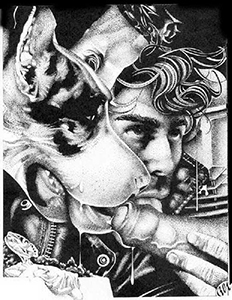
Around 1988, The San Francisco Arts Commission Gallery organized a show with this premise: A prominent Bay Area artist would pick another artist, who would then pick another artist, who would then pick another artist, and then all four would show one work at the gallery in Civic Center, across from City Hall. The performance and installation artist Tony Labat picked me, and then I picked REX, an artist whose work I loved and who was a star of the Gay Leather scene, but was, in my opinion, criminally ignored by the general Bay Area art world. REX in turn picked Mark I. Chester, another important Bay Area artist whose name would not have registered for most of the Art Commission’s patrons.
Each of us was free to select which work we wanted to represent us in the show and while I have no memory of what I included, I’m pretty sure that this was REX’s choice. If not this, he might have chosen its counterpart, where the dog and the greaser are attending to a steel toed boot while a discarded jockstrap oozes a load onto the ground. In any event the picture brought the delights of one of San Francisco’s most important communities into the center of its official civic life. The magic of REX’s work is that it uses the precision of his compositions and the tenderness of his stippling to render his desires iconic and fascinating. The talent ensures that we can’t look away, and once our gaze is held we can revel in the details that he weaves into each picture. His work is hot but never overheated, and he can make a biker piss orgy seem like the most elegant gathering on the planet.
The opening of the Arts Commission show was the first and only time we’ve ever met, but I’m grateful for all his drawings have taught me in the years before and since.
Nayland Blake
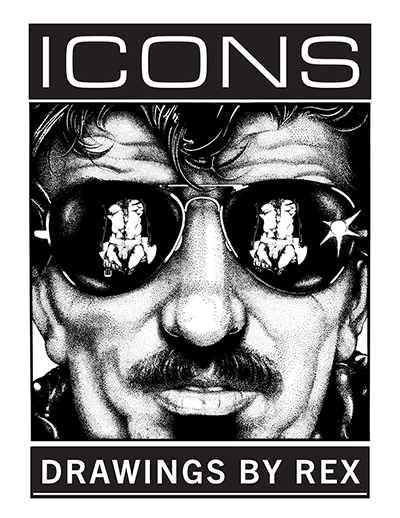
I first discovered REX on a play date. I was at a fist buddy’s house and was looking through the books on his coffee table while he was finishing cleaning out. There it was. Icons: Drawings by REX. A dirty, raunchy collection of black and white images that immediately piqued my interest. As I skimmed through the pages, I saw men smoking, big hairy muscle asses, young boys, daddies, and dogs... each page with the name REX printed in the corner. The boy came out of the shower, and I unfortunately had to put the book down. But the name REX stayed with me, and his images were immediately burned into my mind.
I started to notice more and more of REX’s work around the city: in bars, in homes, and at Auto Erotica, a local store I frequent in the Castro that sells, as its name denotes, erotic art. Despite researching REX online, I was never able to find that book or much of his work available for sale. Perhaps it was out of print. Was REX a name, a set of initials, an acronym, or something else? I discovered that REX was a pseudonym chosen because it was non-specific and non-traceable by the police in a time where gay art at of this nature was criminalized. The sex was not legal; the art depicting it was not either. Despite laws and cultural attitudes changing, REX chose to remain in the background to let his art speak for itself, which to me it most certainly does.
At Auto Erotica, I encountered the largest collection of REXwerk that I have ever seen in person. It was here that I started to collect different pieces of his art: a couple postcards, a handful of prints, and a poster that REX designed for The Caldron, a local San Francisco fisting club. I also found one of my favorite REX prints to date. The print features a jock-strapped man standing over a boy pissing down his neck and back. The man’s ass is covered in fur and his dick is uncut and leaking. You can practically smell the raunch through the image. As someone that is incredibly scent motivated, I find REX’s work to be particularly arousing. In the print, you don’t see either the boy or the man’s face. The only identifying feature of the boy is a tattoo of a bat, a feature which I also identify with.
I love the raunchiness and the exhibitionism. Put simply, REX’s images get my dick hard and my hormone monster raging. His decision to use different shades of black masterfully mirrors the darkness in the sexual scenes he depicts. There is a sense of moral ambiguity inherent in most of his work. Are these scenes depicted consensual? Are these men father and son? Wow, that’s a big dog!
I love REX’s work, enough to want to get it tattooed. I once tracked his email down and reached out, but he has since stopped taking commissions. I still keep an eye out for his books, hoping to find some for his work to add to my collection.
Stephan Ferris


The erotic work of REX stands out to me because it scours the secret world of raunchy man-to-man sex. His characters exist in a film-noir setting that is unashamedly raunchy, with that particular kind of urgency that other well-known artists simply couldn’t capture.
One of the things I noticed in some of his works is that there is an onlooker, a voyeur. And in the instance of “Arm Bum Town”, the voyeur is more like a commentator. One could speculate all manner of things about the role of the voyeur, and that, of course is part of the fun in such a piece.
Robert Roberts, aka Mad Dog, tattoo artist,
author of Mad Dogs and Queer Tattoos: Tattooing the San Francisco Queer Revolution.
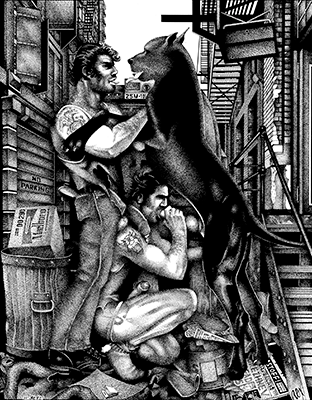

REX’s work is visceral and raw and frequently visualizes taboo kinks, and fringe interests rarely addressed in print. REX has been drawing queer theory before it had a name, and more importantly, REX works as a storyteller. Each illustration defines a facet of our kink culture, and REX chooses to tell it like it is, not how those outside the kink community would prefer to hear it. Fearless in his depictions, REX’s drawings showcase gay male sexuality without omitting the darker aspects of our hunger for more, our lust for the extreme.
The drawing Trash men 11.30.1982 embodies a trifecta of taboos; grimy back alley sex, beastiality, and lust between two breeds of Alpha; man and dog. The image speaks to me on these obvious fronts but also carries profound meaning as a rite of passage. My chosen son and I wear mirror versions of the illustration as tattoos, expressing our pup play sex dynamic while showcasing our Father/son bond. As a subplot to REX’s original story, wearing his work tells the world we are “other,” outliers who dare to voice our desires as they come to us. The ability to find our own stories in REX’s work distinguishes his drawings from all others. REX’s work is beyond mere illustration or “dirty drawings.” It chronicles the depths of our kink culture, spoken without words, yet finds its power in the viewer’s resonance with seeing their fantasies made real.
Chuck Conner
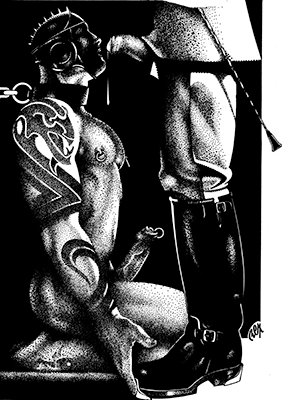
Like most young men, I masturbated a lot. I usually did it while looking at images and personal ads in Drummer Magazine. Yes, personal ads. Reaching an orgasm is mostly an exercise of the brain. I learned to allow my imagination free rein, and personal ads left more room to include the increasingly extreme, twisted and horrible details I needed to get off.
Photographs and drawings too often depicted something that ruled out something else that my head wanted. Once that happened, it was hard to climax looking at that image ever again.
For that reason, I treasure this drawing by Rex. No photograph or work of art helped me shoot more reliably, and that compatibility never faded.
I was aroused by the power differential, so well depicted by the positions of the two men: his cock so close to my mouth, knowing the inevitability of him moving in even closer. I could feel the heavy neck and head bondage. My imagination had made that permanent keeping it in position for this perfectly entitled, masculine officer. I reveled in the joy and the anguish of being his property and victim. I could not help but love the cut of his uniform and the power of his black boots worn outside his trousers. I was proud that he held the crop as he did, knowing that he used it on me as often and as hard as needed, wanting him to use it to maximize his satisfaction.
But the coup de grace was on the floor. In almost all other similar pictures, the bottom’s arms and hands are also bound, or the bottom is touching the top’s legs or ass or balls, bringing him pleasure. For me, that bondage or that service would not assure greater compliance or devotion. For me, this man is greater, and this art is more compelling.
Rex left my hands free so I would willingly put them in the place where the officer would trap my fingers with his heavy, hard, unfeeling boots, guaranteeing and certifying our mutual arousal. Rex knew this about me, and about others like me.
As the drawing shows, his cock proves his supremacy, and my cock confesses what he al- ready knows. In my head he moved closer, naturally, his boots crushing more of me, enabling even more loyal service.
Outside the drawing, as my actual right hand stroked my actual hard cock, there was no way to evade or deny who I was. Rex showed the world what kind of man he had found in me. I was grateful to be locked here forever, and happy that my gratitude was unequivocal. With all this and more in mind, I reached one seismic orgasm after another, day after day, for years.
Thank you, Rex, for drawing my portrait so well.
Bob Miller,
Founder & Executive Director of the Leather Hall of Fame

When REX was living in New York City, he had a boyfriend who owned a horse that was kept at a track stable in New Jersey. One day REX took a Trailways bus over to New Jersey to meet up with him. REX waited for his boyfriend in his truck while he tended to his horse. This is when REX envisioned this drawing.
Everything inside this 50s truck was real including the gun, the pack of Camels, the can of Budweiser, and REX’s Trailways ticket over the visor. The boyfriend appears through the windshield.
Clyde Wildes
This drawing takes me back to my college days, when I used to cruise the city park near my university. Of course, I never had a sublime hunk step on my hood with his giant dick hanging behind my windshield being the only part of him I could make out. There, instead, guys would leave their car in the parking lot and either walk up to your car, chat, and get into the passenger seat to suck you or take a walk into the bushes where I’d join them to get a blow job and give a fast fuck.
Yet how do I wish some hot hairy dude would have jumped up on my hood to jerk off while I was jerking off watching him... or, better yet: had done so while I was fucking in the bushes, only for me to find him on my hood as I was walking back to my car!
What throws this one over the edge for me is the guy to the side watching/being an audience to what’s happening: is he walking back to his truck and, in a twisted way, the intended audience for the hunk jerking? Or is the intended audience in the truck, which would then put the guy in the background in a position of voyeur, walking into a scene he was not supposed to see (as we, viewers of the drawing, all are) but in which he is nevertheless welcome? If he is in fact the owner of the truck, is he turned on by what he is seeing? At least amused? Or is he enraged and ready to grab the gun in the truck to teach the hunk a lesson?
That’s what I like most about REX – his way of putting you at the intersection of hot and dangerous, often without telling you for sure on which side you’ll end — perhaps because the two are inseparable? And his way of making you witness things you did not expect to see, you may not have wanted to see, and yet things that are unquestionably about you and that welcome you.
I’ve had many satisfying jack-off sessions to REX’s drawings - I’d like him to know that and I thank him for it.
Gary Keener
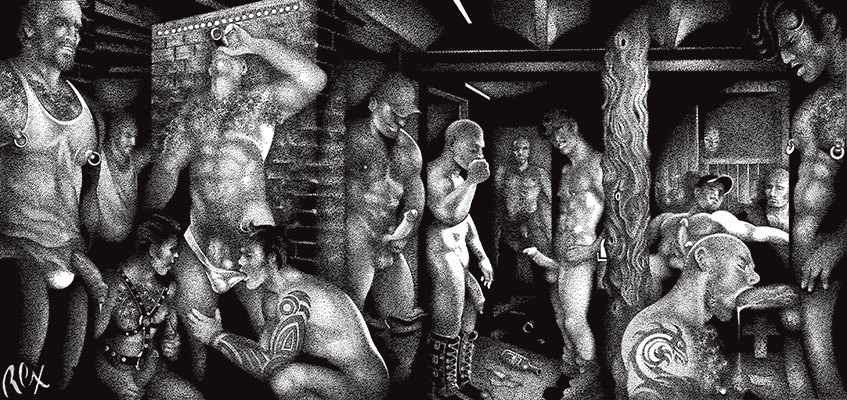
I visited REX in Amsterdam in the Summer of 2019. After I admired this drawing, which is REX’s version of Rembrandt’s The Night Watch, REX took me to the basement darkroom of the Cuckoo’s Nest bar at Nieuwezijds Kolk 6, Amsterdam. This is where he envisioned the scene depicted in this drawing.
If you visit the darkroom, look around at the bottom of the stairs and perhaps you too will recognize this scene. Of the 13 faces in the drawing, which one is REX? He drew himself as one of the horny men in this scene.
Clyde Wildes
A remembrance by Ad Schuring
I cannot remember when I first got to see REX’s drawings, but I guess that must have been in the early 1980s, at an adult bookstore on Haarlemmerdijk. I used to go there and leaf through the mags (mostly without buying). Drummer was my favorite: not only because it explored the outer edges of kinks and made me feel at ease, confirming I was not alone and there was an abundance of pigfags out there; but also because it featured a bunch of brilliant illustrators and visionaries of that underworld. On the occasion that I did buy a copy, it was primarily for the drawings of REX and Bill Ward.
Bill Ward and REX worked in black ink. REX in particular had mastered a technique that allowed him to overcome the limitations of budget printing of those days. By painstakingly doing the shade-gradation himself with millions of tiny inkdots, he took out the need to raster the images, still emphasizing amazingly suggestive lit or dark spaces, and even more fantastic body, ass and cock shapes.
A few years later, I got to know the two main Dutch artists, Willem Kok (aka Dorus) and Martin of Holland, main illustrators of Centurion, the most extreme Dutch gay S&M magazine. I also got to know their friends Bastille, the Hun, Rick Castro, Axel, as they came to Amsterdam and exhibited at RoB and MrB. Willem Kok’s place became my Amsterdam pied-a-terre whenever I worked in Amsterdam. And that is how I started posing for him whenever he needed someone in an anatomically impossible position for a leather of fetish poster. I still feel the cramps. I would never have tried these poses on my own, but they felt surprisingly comfy when it all was done for art’s sake.
A submissive model was born!
Through Willem and Martin, I also met Durk Dehner. We both had the experience of being a model (he had been the muse of Tom of Finland), and we shared a passion for promoting queer artists. At one of the Tom Foundation’s art fairs I visited, I learned that REX was planning a move to Amsterdam and was asked if I could help him find his way through the city.
That was too good to be true: assist my porn-art hero, WOW !
REX and I immediately became friends and, as I had been asked, I helped him get settled and, over the years, worked with him when he had to appear at cultural events or in local media.
We had our share of intense conversations and passionate disagreements, but remained loyal to each other: keeping our friendship apart from any business and commercial entanglement had a lot to do with it.
Early on, REX asked to visit his own hero, the equally uncompromising scat pioneer Martin of Holland, then at the very end of his life. He managed to make it to den Haag just in time.
More fun was touring him around the Dutch countryside, on my motorcycle, showing Den Haag’s Parliament, our sea defences and, more importantly, our nude beaches, cruising areas, clubs and bars.
For his first months in Amsterdam he stayed at the Anco Hotel, a landmark of leather history. Posing for him there felt natural. As for the portrait, he set up a scene in one of our favorite darkrooms at Cuckoos’ Nest.
No longer for art’s sake; I was at home, immortalized by REX, slobbering cum and piss, deter- mined not to miss one drop; that felt just right!
Sadly, shortly after, REX felt his hand was losing its stability: he had to drop his pen and retire. The portraits of Jaques Zonne, coat-check/host guy of the Web Bar, and myself are probably his last drawings.
Although his work, notably for the Mineshaft and Drummer, was seen by millions (for example when Freddie Mercury wore a REX t-shirt) and made him one of the foremost visionaries of kink, he had firsthand experience of censorship and repression, starting his art career in NYC in the 1960s, a time when the city was largely under MAFIA rule. Two decades later, he lost everything he had: business, apartment, all his original drawings, in the 1981 Folsom street fire. The leather panic that ensued and further victimized the victims of the fire was another instance of wild bigotry that he experienced.
That probably helps explain why he has so consistently stayed out of the spotlight his work enjoyed. He is exceedingly weary of appearing in public: only very reluctantly did he accept to attend the recent exhibitions he had in Amsterdam, Berlin and Antwerp. He much prefers to just be approached through the contact form of his website than in person. The spotlight spooks him; he even asked me to accept the lifetime achievement award of the Tom of Finland Foundation on his behalf.
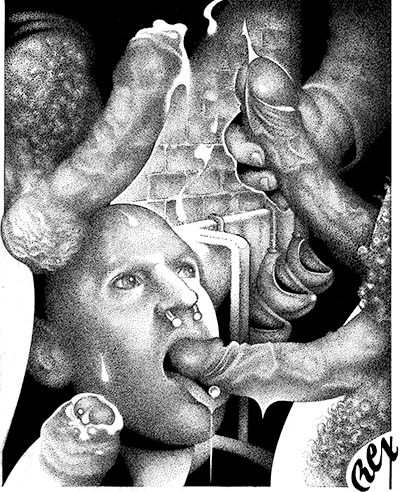
That does not mean, however, that he is indifferent or not grateful. At the time, he did write an acceptance note that he asked Sharp and myself to read at the ceremony. His words remain just as relevant today, as he is inducted into the Leather Hall of fame:
“Against prejudice, violence, threats and bigotry we defiantly took pride in openly deipict- ing our counterculture lifestyles and rituals to the world a half-century ago. Mine was the first generation that came out of the closet to the art world, the decade before Stonewall.
We paid a heavy price in those early days for drawing dirty pictures as they were then called, sacrificing our lives, our health, our jobs, our families and homes for daring to depict “The Love That Dare Not Speak Its Name.”
Our art was burned and destroyed in raids by civil and postal authorities, condemned and spat upon by church and state, and especially despised by the art world itself for whom we were rude intruders, storming the gates of their conservative ivory towers.
Therefore, it is with great humility that I accept this award on behalf all those artists of my generation who did not survive our epic battle to give gay art the prominence it currently enjoys in the world today.
Thank you, REX”
